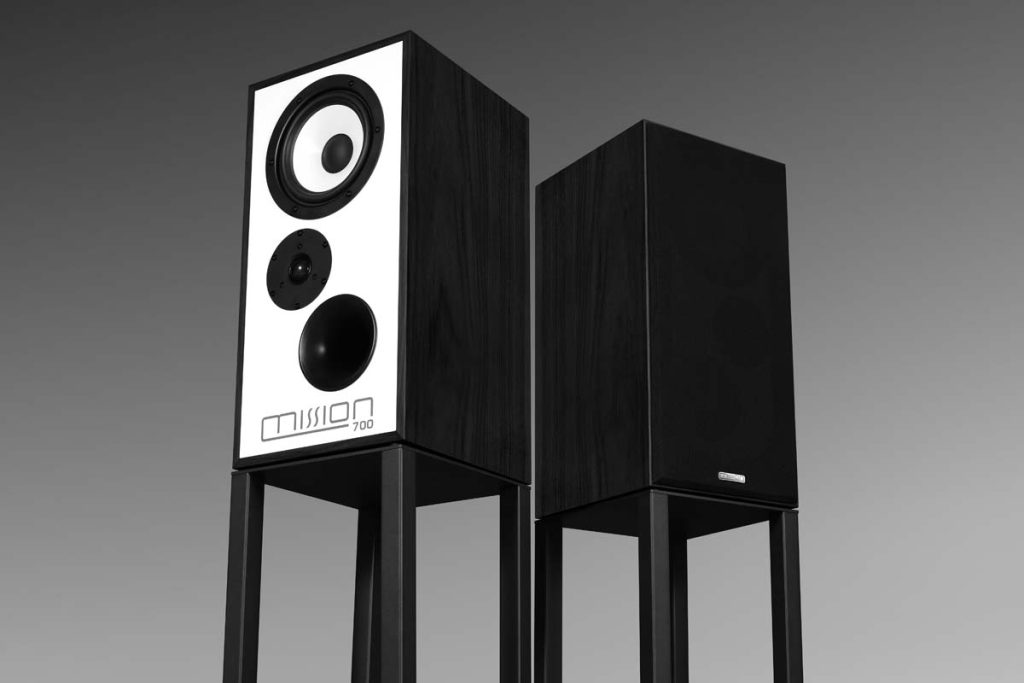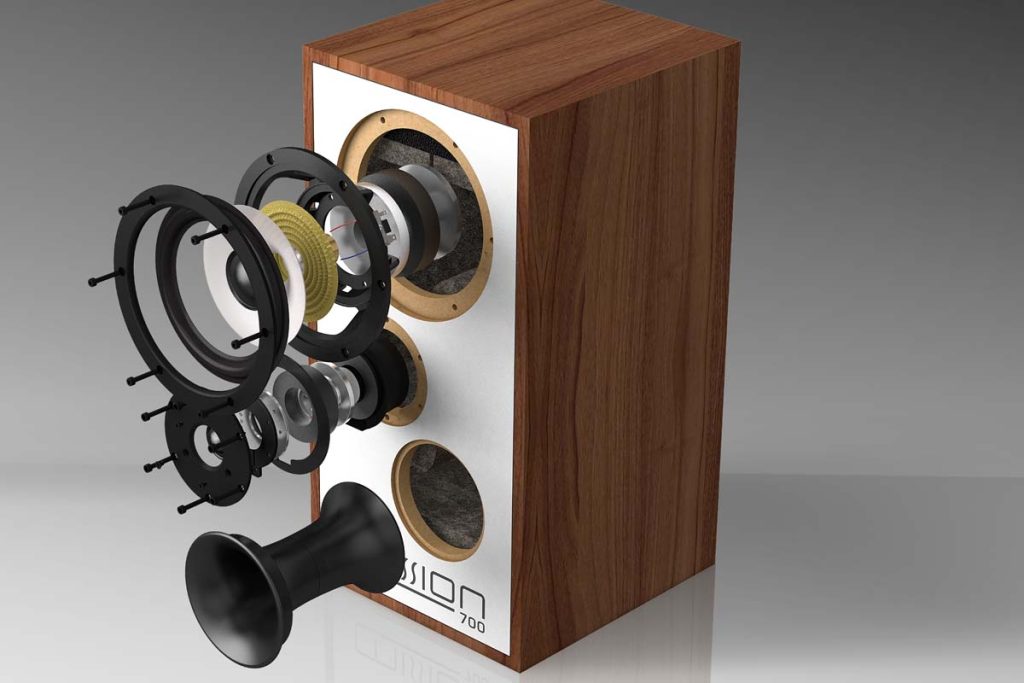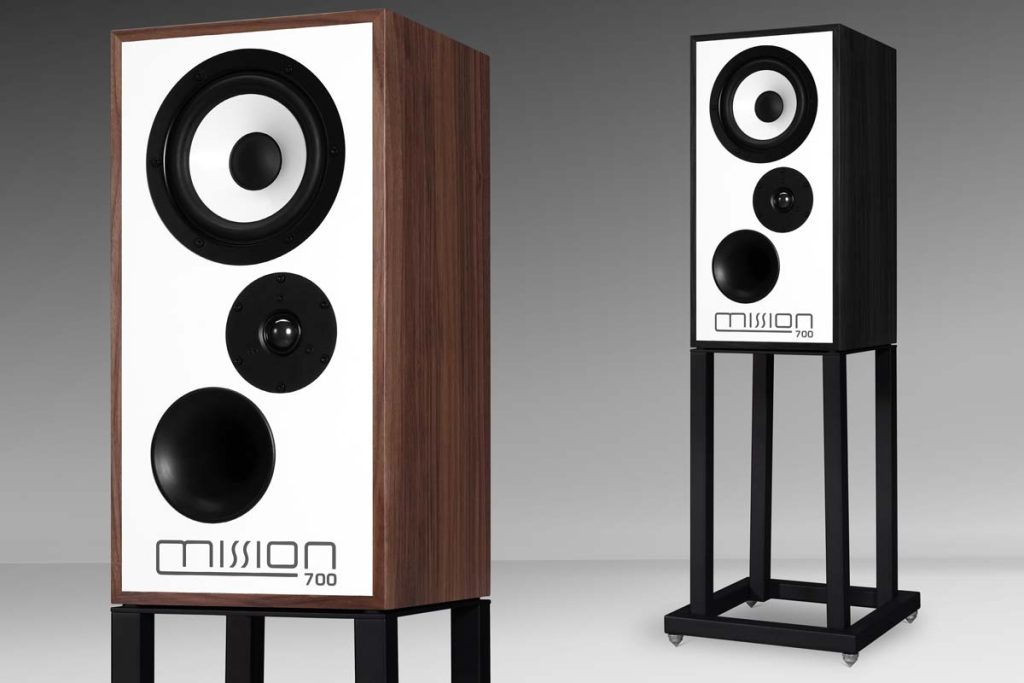Up until the 1980s, it was easy to identify the speakers of a particular brand from afar in the dealer’s display window due to their design. Mission, along with its sister brand Wharfedale, has now taken advantage of this and revived one of those “classics with a face”. The new Mission 700 means to continue the current success story of its big sister, the 770.
In addition to the relaunch of the Mission 770, developer Peter Comeau is also known to be responsible for the very successful Wharfedale Linton reissue. While the latter is tuned rather warm and close to the historical model, Comeau takes the Mission 700 series right into the present – sonically and technologically. The only thing that remains historic here is the look, which is quite close to the original 700 from 1980. Today, the tweeter is installed asymmetrically below the mid-bass driver. Mission called this “inverted driver geometry” back then, which sums it up very well. Below the tweeter, the bass reflex tube of the two-way system is directed towards the listening position. The classic Mission lettering is prominently displayed at the bottom of the white baffle.
However, every detail of the original has been reworked for the new 700. This starts with the drivers and continues on to the crossover and to the cabinet design. The white cone of the woofer is made of polypropylene, as has long been Mission’s custom. However, mineral components have been added to the plastic here to increase rigidity. A trick that Comeau already applied to the 770. The driver has also been adapted to current requirements in terms of load capacity and dynamics. The modified geometry of the die-cast basket should ensure that fewer initial reflections and thus discolorations can occur.
Speaking of bass. I’m playing Iggy Pop’s version of “You Want It Darker,” found on the new Leonard Cohen tribute album, via Qobuz HiRes. Iggy Pop goes head-to-head with the late old master on this one. Who would have thought that someone could sing almost deeper than Cohen? The foundation is stable, the voice speaks to me from the stereo center with a slightly grumbling attitude, but it still sounds realistic – that’s Iggy Pop for you. At the same time, the shell of the deep drum takes its tonal place below his vocal performance. The bass of Scott Colley also shows itself as an instrument that can be clearly differentiated, albeit a bit softer and with a shot of warmth. However, this is due to the production of Larry Klein, who captured the instrumental ensemble for the album around guitarist Bill Frisell in the style of a large jazz combo. “If It Be Your Will,” interpreted by Mavis Staples, sounds even more haunting. The Mission 700 places the extremely cleanly recorded voice right in the stereo center. This is to say that it is not a technical voice reproduction that is exclusively fixed to a too narrow position, but a reproduction with an almost visible body that just appears shoulder wide in the listening room and does not become too narrow, as with many other speakers.
The vertical action is also seamless; the reproduction, which is entirely detached from the speakers, devotes the same care to the entire frequency range of the voice. The “perfect” midrange frequencies that used to be typical for “Brit-Fi” are of course there, but nothing is cut off above and below that with the new 700. Especially the difficult transition between tweeter and woofer seems to be excellently solved in the Mission. The crossover frequency is at a comparatively high three kilohertz, so the new mid-bass driver is responsible for reproducing the majority of the human voice, which essentially acts between 300 and 3400 hertz. The new Mission tweeter is therefore allowed to concentrate on the range that is generally responsible for the impression of space, but also for the important overtones that give voices and instruments their individuality. A 28-millimeter driver made of microfiber fabric operates in its own chamber, which shifts the tweeter’s resonant frequency to a range that lies below the high-pass filter of the crossover, i.e. it can no longer interfere with the sound. Thus, the new chassis sounds clear and open on the one hand, yet never sharp or colored on the other. The advantage here is that the complete production of the loudspeaker is in the hands of the International Audio Group – including the chassis. Thus, Peter Comeau can implement his sonic ideas without compromise through purchased drivers. In my opinion, the new crossover is another essential aspect for the successful performance. This has been developed with software support in keeping with the times. Thus, many parameters could be adjusted in advance in virtual test runs before the first test board even had to be soldered. This saves time and resources. By the way, the components for the tweeter and the bass-midrange crossover network are each located on a circuit board of their own.
The well-produced new Pixies record Doggerel demands quite different qualities from the speakers. The wiry bass, the grating voice of Black Francis as well as the powerful rock drums all want to get their place in the sound image next to the distorted guitar, and the 700 manages that very well! I hear a flawless representation of all sound bodies, and the dynamics of the arrangement of “Vault Of Heaven” are presented to me unadulterated. The bass is recorded in a much more poignant way here than on the Cohen tribute I heard before. The Mission 700s obviously benefit from the redesign of the mid-bass driver in this one, which sends a punchy low end into the listening room without ever booming. The bass and the drum kit don’t get in each other’s way, even the low strings of the electric guitar get their place without getting lost in the crowd of sounds. For just under 25 liters of cabinet volume, the Mission 700 goes down pleasantly low. No, it doesn’t replace a full-blown floorstanding speaker, but it is a holistic representation of the music, especially on the perfectly fitting stands. This already works with a good 12 tube watts, but with power beyond 50 watts from semiconductors a nuance more definition and thrust is added, which was to be expected with the stated 86 decibels efficiency (2.8 V/1 m).
I add in a few bars from the Linn LP12 Selekt. I feel like listening to “Private Investigations” by Dire Straits again. The dry electric bass of John Illsley towards the end of the piece alone excites me to hear this piece at least once over the 700. The holographic capabilities of the Scottish turntable are impressive to experience even through the affordable Mission speakers, despite the large price difference. The acoustic guitar at the beginning, Knopfler’s voice in the wide reverberation chamber, the xylophone played with a light beat in the background and the deep keyboard blanket lead me to the spatially recorded steps that lead directly to the dry electric bass mentioned at the beginning. The Mission follows the fast transients of the guitar and toms as well as the small sound details in the depth of the recording. At the same time, the high-frequency range remains tidy and without any sharpness. The bass range is natural, dynamic and focused. This means that the low tones do not linger, thickly billowing across the room, but rather can unfold naturally. The slight overemphasis of the upper mids, which used to be popular with bookshelf speakers, does not exist in the modernized Mission 700!
In order to create all these impressions in the listening room, a word about an equally decisive component that has not been mentioned so far: the cabinet. In the Mission 700, this consists of a two-layer wooden construction made of MDF and chipboard, which is additionally equipped with internal stiffeners. As a result, Peter Comeau and his team have “pushed” the resonant frequency of the cabinet below the audible range. And the damping material inside was calculated in quantity so that the mid-bass driver does not lose its liveliness. The manufacturing quality of the speaker built in the Chinese IAG factory is beyond reproach, and the same goes for the absolutely recommendable speaker stands.
The new Mission 700 takes the good and unique approaches of the classic two-way predecessor speaker from the 80s one step further and combines a familiar look with contemporary, high-resolution sound that wants to spread especially in small and medium-sized rooms. Transparency, dynamics and a seamless presentation of all frequencies, detached from the speakers, are on the credit side of the 700. Considering the asking price, quite a few competitors might be in for a rough ride.
Accompanying Equipment
CD-Player/DAC: Luxman D-N150 | Streamer: Volumio | Turntable: Linn LP12 Selekt, Elac Miracord 70 with Audio-Technica AT33-PTG/II, Rega Planar 3 | Phono preamp: Luxman E-250 | Integrated amplifier: Luxman SQ-N150 | Preamplifier: Audiolab 8200CDQ | Power amplifier: Audiolab 8200P | Loudspeakers: Klipsch Heresy IV | Cable: Ecosse, TaraLabs, HMS, Furutech, Supra
Loudspeaker
Mission 770
Concept: Ported two-way standmount loudspeaker | Driver complement: polypropylene-mineral mid-bass woofer, microfiber tweeter | Crossover frequency: 3 kHz | Inputs: single-wire five-way binding posts | Impedance: 8 Ω | Sensitivity: 86 dB at 2,8 V/1 m | Frequency response (±3 dB): 45 Hz – 20 kHz | Recommended amplifier power: 25 W and up | Dimensions (W/H/D): 32/49/33 cm | Weight: 12,8 kg | Warranty period: 5 years | Price per pair: around 1500 € (matching stands around 380 € per pair)
IAD GmbH
Johannes-Georg-Halske-Straße 11
41352 Korschenbroich
Telefon +49 2161 617830
info@iad-gmbh.de


















